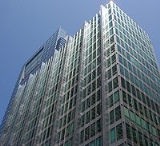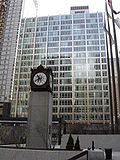
Inland Steel Building
Encyclopedia

Chicago
Chicago is the largest city in the US state of Illinois. With nearly 2.7 million residents, it is the most populous city in the Midwestern United States and the third most populous in the US, after New York City and Los Angeles...
, is one of the city's defining commercial high-rises of the post-World War II
World War II
World War II, or the Second World War , was a global conflict lasting from 1939 to 1945, involving most of the world's nations—including all of the great powers—eventually forming two opposing military alliances: the Allies and the Axis...
era of modern architecture
Architecture
Architecture is both the process and product of planning, designing and construction. Architectural works, in the material form of buildings, are often perceived as cultural and political symbols and as works of art...
. It was built in the years 1956–1957 and was the first skyscraper
Skyscraper
A skyscraper is a tall, continuously habitable building of many stories, often designed for office and commercial use. There is no official definition or height above which a building may be classified as a skyscraper...
to be built in the Chicago Loop
Chicago Loop
The Loop or Chicago Loop is one of 77 officially designated Chicago community areas located in the City of Chicago, Illinois. It is the historic commercial center of downtown Chicago...
following the Great Depression
Great Depression
The Great Depression was a severe worldwide economic depression in the decade preceding World War II. The timing of the Great Depression varied across nations, but in most countries it started in about 1929 and lasted until the late 1930s or early 1940s...
of the 1930s. Its principal designers were Bruce Graham
Bruce Graham
Bruce John Graham was an Colombian-American architect. Among his most notable buildings are the Inland Steel Building, the Willis Tower , and the John Hancock Center. He worked with Fazlur Khan on all three constructions...
and Walter Netsch
Walter Netsch
Walter Netsch was an American architect based in Chicago. He was most closely associated with the brutalist style of architecture, as well as the firm of Skidmore, Owings, and Merrill. His signature aesthetic is known as Field Theory and is based on rotating squares into complex shapes...
of the Skidmore, Owings & Merrill architecture firm.
The use of brushed stainless steel
Steel
Steel is an alloy that consists mostly of iron and has a carbon content between 0.2% and 2.1% by weight, depending on the grade. Carbon is the most common alloying material for iron, but various other alloying elements are used, such as manganese, chromium, vanadium, and tungsten...
cladding reflects the corporation that commissioned the building as its headquarters, the Inland Steel Company
Inland Steel Company
The Inland Steel Company was a U.S. steel company active in 1893-1998. Its history as an independent firm thus spanned much of the 20th century. It was headquartered in Chicago, Illinois at the landmark Inland Steel Building....
. The placement of all structural columns on the building's perimeter—and the consolidation of elevators and other service functions in a separate tower—allowed for a highly flexible interior floor layout with no interior columns. This design is a good example of the widely held principle of the era, "form follows function
Form follows function
Form follows function is a principle associated with modern architecture and industrial design in the 20th century. The principle is that the shape of a building or object should be primarily based upon its intended function or purpose....
" (Louis Sullivan).
The Inland Steel Building was designated a Chicago Landmark on October 7, 1998.

